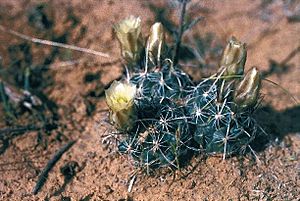Siler fishhook cactus facts for kids
Quick facts for kids Siler fishhook cactus |
|
|---|---|
 |
|
| Scientific classification |
The Sclerocactus sileri, also known as the Siler fishhook cactus, is a very rare and small type of cactus. You can find it mostly in desert areas that have lots of minerals. These areas are usually at medium heights above sea level. This special cactus grows in parts of Utah, Nevada, and northern Arizona in the United States.
Contents
What Does the Siler Fishhook Cactus Look Like?
The Siler fishhook cactus can grow to be about 25 centimeters (about 10 inches) tall. It can also be up to 12 centimeters (about 5 inches) wide.
Flowers and Spines
This cactus has pretty flowers that are about 20 millimeters (less than an inch) wide. Their petals are usually whitish or yellowish. You might see purple lines, like veins, on the petals. These flowers bloom in the spring.
The Sclerocactus sileri has two main types of spines: central spines and radial spines.
- Central Spines: These spines are brownish-black and can be up to 30 millimeters (about 1.2 inches) long. There are usually four to five central spines in each cluster. One of these spines is often white and strongly hooked, curving towards the ground.
- Radial Spines: These spines are white and shorter, usually up to 20 millimeters (about 0.8 inches) long. There are about six to eight radial spines in each cluster.
Seeds and Fruits
The seeds of this cactus are small, about 2.2 to 2.5 millimeters wide. They can be black or light brown.
The flowers and fruits of the Siler fishhook cactus are similar to other cacti in its family. Its flowers usually bloom in April and May. The fruits appear in May and June. The fruit starts green and turns red as it ripens. It is dry and opens up to release the seeds.
Understanding the Siler Fishhook Cactus Name
The names Sclerocactus sileri and Pediocactus sileri can be a bit confusing. For a while, some scientists thought they were the same. However, most experts now agree they are two different species.
- Sclerocactus sileri was first named in 1969. It was later recognized as its own species in 1994. It is known as the Siler fishhook cactus.
- Pediocactus sileri was named in 1896. It is often called the Gypsum cactus or Siler's pincushion cactus.
Even though they have similar names, they are distinct plants. They are found in different, though sometimes close, areas.
Where Does the Siler Fishhook Cactus Live?
The Sclerocactus sileri cactus is found in a very small area. It lives only in Coconino County, Arizona, in the United States. This area is very close to the border with Utah.
What Kind of Home Does the Siler Fishhook Cactus Like?
The Siler fishhook cactus is a plant that grows in dry places. It likes habitats like deserts, scrublands, and grasslands. It especially loves desert shrub areas.
Soil and Plant Friends
This cactus grows best in dry soils that have a lot of minerals. It particularly likes sandy soils that are rich in gypsum and salt. You can often find it growing near grama grass.
Other plants that often grow near the Sclerocactus sileri include:
- Drop seed grass (Sporobolus)
- Yucca plants (Yucca)
- Hedgehog cactus (Echinocereus)
- Sagebrush (Artemisia)
- Snakeweed (Gutierrezia)
- Pinyon pine trees (Pinus edulis)
- Juniper trees (Juniperus)
The Sclerocactus sileri is a perennial succulent. This means it lives for many years and stores water in its thick parts. It is native to the western United States. It usually grows at elevations between 850 and 1,650 meters (about 2,790 to 5,410 feet) above sea level.
Usage
The Sclerocactus sileri has no known uses for humans.

